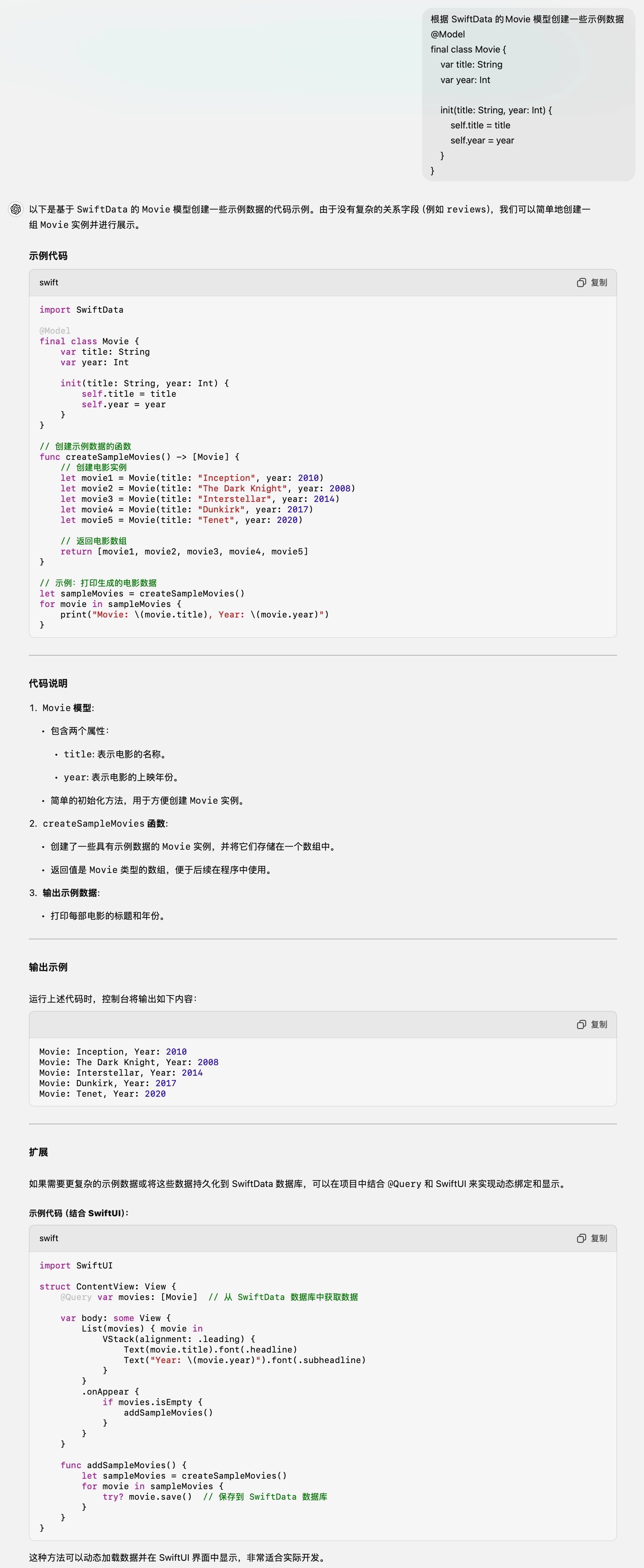温馨提示:本文最后更新于
2025-01-18 12:33:10,某些文章具有时效性,若有错误或已失效,请在下方留言。ModelContext 是 SwiftData 中负责跟踪所有在内存中创建、修改和删除的对象的组件。它确保这些对象能够在稍后某个时刻保存到模型容器中。ModelContext 提供了一个便捷的方式来管理对象的状态,使开发者能够轻松执行 CRUD(创建、读取、更新、删除)操作而不必担心对象的持久化细节。通常,ModelContext 与 ModelContainer 和 ModelConfiguration 配合使用,共同实现数据的高效管理和操作。
import SwiftUI
import SwiftData
struct ContentView: View {
@Environment(\.modelContext) private var context
}
插入新模型
这个示例展示了如何在 SwiftUI 中插入一个新模型到 ModelContext。
import SwiftData
@Model final class Recipe {
var id: UUID
var name: String
var destination: String
init(id: UUID = UUID(), name: String = "", destination: String = "") {
self.name = name
self.destination = destination
}
}
struct AddRecipeView: View {
@Environment(\.modelContext) private var context
@State private var recipeName: String = ""
var body: some View {
VStack {
TextField("Recipe Name", text: $recipeName)
Button("Add Recipe") {
let newRecipe = Recipe(name: recipeName)
context.insert(newRecipe) // 插入新模型
recipeName = "" // 清空输入框
}
}
}
}
更新模型
在这个示例中,您可以更新现有模型的名称。更新后,如果自动保存未被启用,可以选择手动保存。
import SwiftData
struct RecipeListView: View {
@Environment(\.modelContext) private var context
@Query private var recipes: [Recipe]
var body: some View {
List(recipes) { recipe in
HStack {
Text(recipe.name)
Spacer()
Button("Edit") {
// 更新模型
if let index = recipes.firstIndex(where: { $0.id == recipe.id }) {
recipes[index].name = "Updated Recipe Name"
// 如果禁用了自动保存,这里需要手动保存
// try? context.save() // 手动保存更改
}
}
}
}
}
}
删除模型
这个示例展示了如何从 ModelContext 中删除一个模型。删除操作将使该模型从持久化存储中移除。
import SwiftData
struct RecipeListView: View {
@Environment(\.modelContext) private var context
@Query private var recipes: [Recipe]
var body: some View {
List(recipes) { recipe in
HStack {
Text(recipe.name)
Spacer()
Button("Delete") {
context.delete(recipe) // 删除模型
}
}
}
}
}
保存更改
如果自动保存被禁用,您可以手动保存更改或使用 rollback() 来放弃未保存的更改。
import SwiftData
struct RecipeDetailView: View {
@Environment(\.modelContext) private var context
@Query private var recipes: [Recipe]
var body: some View {
Button("Save Changes") {
do {
try context.save() // 手动保存更改
} catch {
print("Failed to save context: \(error)")
}
}
}
}
如何不需要错误信息,可以通过下面方式保存更改
Button("Save Changes") {
try? context.save() // 手动保存更改
}
手动创建新上下文时,自动保存通常是禁用的。可以通过调整 autosaveEnabled 属性来启用自动保存。如下所示
let newContext = ModelContext(container)
print(newContext.autosaveEnabled) // 查看自动保存状态
newContext.autosaveEnabled = true // 启用自动保存
总结
通过实例展示了如何使用 ModelContext 进行模型的插入、更新、删除和保存操作。通过 @Environment(\.modelContext),您可以轻松访问和管理模型数据,确保应用的快速性和持久化存储保持同步。
© 版权声明
THE END









暂无评论内容